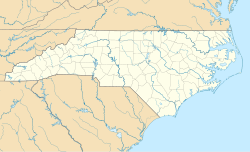History
The Episcopal Diocese of East Carolina was formed by the General Convention of the Episcopal Church on October 22, 1883. [2] In the following December, John D. Grimsley represented the congregation of St. Barnabas at a convention held at Christ Church in New Bern, North Carolina, to organize the newly formed diocese. [2] A new congregation formed in Snow Hill was assigned to the Rev. Israel Harding as part of his circuit of churches. [2] By May 1884, Harding officiated four services in Snow Hill, despite the lack of a church building. [2] At that time, the earliest services were held in the Green County Courthouse, but later the Baptist Church allowed the congregation to use its facilities. [2] There was always the intention to build a house of worship. [2] Bishop Alfred Watson, after delivering a sermon in the courthouse on October 24, 1884, spoke with members of the congregation regarding the erection of a church. [2] Two and one-half acres owned by Aquilla Sugg were acquired by the Diocese in 1883, but no funds were available for construction. [2] Using funds raised locally, John D. Grimsley, William E. Best, John Harvey, and Theophilus Edwards brokered a deal with W. T. Faircloth and the firm of Porter and Godwin to construct the building ,which was completed in 1887. [2] The new church was named St. Barnabas, which had been the name of the congregation. [2]
The Rev. Israel Harding remained the priest in charge of St. Barnabas until his death in 1891. [2] The church was not consecrated during Harding's lifetime because a canon of the Episcopal Church withheld the consecration of a parish until it had paid off its debt. [2] The final loan payment was made in early 1893, and on April 23 of that year, Bishop Alfred Watson consecrated St. Barnabas in honor of Israel Harding. [2]
In 1952, sparks from the wood stove ignited the shingle roofing underneath the tin covering. [2] The tin prevented the fire from destroying the church. [2] G. Frank Warren, the treasurer of St. Barnabas from 1938 to 1962, had the damaged roof replaced with timber cut to resemble the original woodwork. [2]
Over time, the older members of the church passed away and, the Diocese became increasingly reluctant to assign a regular minister to the congregation. [2] The number of communicants dwindled, until in 1962, the Diocese could no longer justify keeping the church active. [2]
In 1971, five teenage boys entered the abandoned church and wrecked the interior. [2] The stained glass window over the altar was broken; hymn books were torn and used as projectiles to destroy the glass light fixtures; a hole was knocked in the ceiling; swinging doors to the vestibule were ripped to shreds; roofing cement was poured on the floor, carpet, and pews; the baptismal font was chipped and broken; covers for the kneelers were split open; the pump organ (which had been converted to electricity) was damaged beyond estimation; and the church and grounds were littered with beer cans and other debris. [2]
Today, St. Barnabas is no longer a parish and currently meets only twice a year, on a Saturday near the feast day of St. Barnabas and another Saturday in October, celebrating the Holy Eucharist from the 1928 American Book of Common Prayer. [3] Its last service as a parish was held in 1962. [4]
St. Barnabas is under the pastoral care of St. Mary's Episcopal Church in Kinston, North Carolina. [3]
It was listed on the National Register of Historic Places in 1979. [1]
This page is based on this
Wikipedia article Text is available under the
CC BY-SA 4.0 license; additional terms may apply.
Images, videos and audio are available under their respective licenses.




